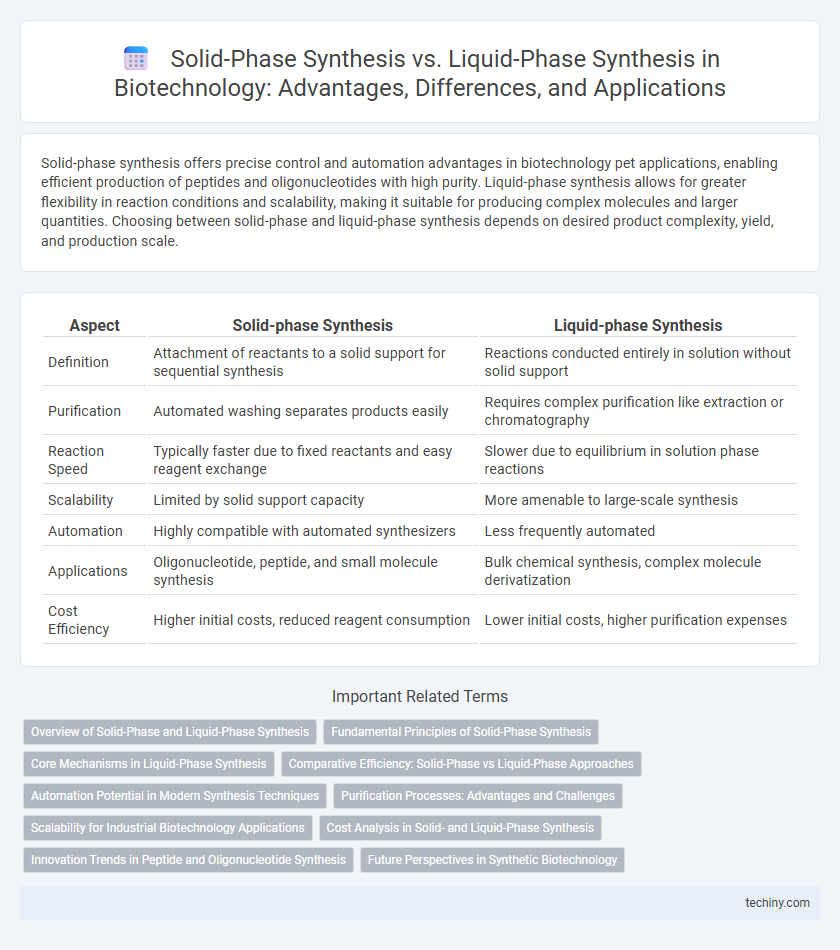Solid-phase synthesis offers precise control and automation advantages in biotechnology pet applications, enabling efficient production of peptides and oligonucleotides with high purity. Liquid-phase synthesis allows for greater flexibility in reaction conditions and scalability, making it suitable for producing complex molecules and larger quantities. Choosing between solid-phase and liquid-phase synthesis depends on desired product complexity, yield, and production scale.
Table of Comparison
| Aspect | Solid-phase Synthesis | Liquid-phase Synthesis |
|---|---|---|
| Definition | Attachment of reactants to a solid support for sequential synthesis | Reactions conducted entirely in solution without solid support |
| Purification | Automated washing separates products easily | Requires complex purification like extraction or chromatography |
| Reaction Speed | Typically faster due to fixed reactants and easy reagent exchange | Slower due to equilibrium in solution phase reactions |
| Scalability | Limited by solid support capacity | More amenable to large-scale synthesis |
| Automation | Highly compatible with automated synthesizers | Less frequently automated |
| Applications | Oligonucleotide, peptide, and small molecule synthesis | Bulk chemical synthesis, complex molecule derivatization |
| Cost Efficiency | Higher initial costs, reduced reagent consumption | Lower initial costs, higher purification expenses |
Overview of Solid-Phase and Liquid-Phase Synthesis
Solid-phase synthesis involves anchoring reactants to an insoluble support, enabling efficient reagent removal and automation, making it ideal for peptide and oligonucleotide production. Liquid-phase synthesis occurs entirely in solution, offering flexibility for complex molecule assembly but often requiring extensive purification steps. Both methods are critical in biotechnology, with solid-phase favored for high-throughput and solid-support advantages, while liquid-phase allows broader chemical diversity and scalability.
Fundamental Principles of Solid-Phase Synthesis
Solid-phase synthesis relies on anchoring the initial reactant to an insoluble polymeric resin, allowing sequential addition of reagents while facilitating easy separation of products from unreacted materials by simple filtration. This methodology significantly enhances purification efficiency and automation potential, making it the preferred approach for synthesizing peptides, oligonucleotides, and complex small molecules. The immobilization on a solid support minimizes side reactions and improves overall yield through iterative cycles of coupling, washing, and deprotection.
Core Mechanisms in Liquid-Phase Synthesis
Liquid-phase synthesis in biotechnology involves the sequential addition of reactants in a homogeneous solution, allowing for continuous monitoring and optimization of reaction conditions. Core mechanisms include nucleophilic substitution, protection-deprotection cycles, and purification through extraction or precipitation, facilitating efficient chain elongation. This method offers high purity of products and flexibility in scaling synthesis for peptides, oligonucleotides, and small molecules.
Comparative Efficiency: Solid-Phase vs Liquid-Phase Approaches
Solid-phase synthesis offers higher efficiency by facilitating rapid purification and automation, reducing reaction times compared to traditional liquid-phase methods. Liquid-phase synthesis allows greater flexibility in reaction monitoring and scale-up, but typically involves more complex purification steps, impacting overall throughput. The choice between these methods depends on the specific biotechnological application, balancing speed and scalability against precision and adaptability.
Automation Potential in Modern Synthesis Techniques
Solid-phase synthesis enables higher automation potential in modern biotechnology due to its streamlined workflow and ease of washing away excess reagents, which reduces manual intervention and error rates. Liquid-phase synthesis, while versatile, presents challenges for automation because of complex purification steps and difficulties in reagent removal. Advances in robotic handling and microfluidics technologies have particularly enhanced the scalability and reproducibility of solid-phase synthesis in peptide and oligonucleotide production.
Purification Processes: Advantages and Challenges
Solid-phase synthesis simplifies purification by allowing easy separation of the growing molecule from soluble impurities through immobilization on a solid support, reducing the need for complex extraction steps. Liquid-phase synthesis often requires more labor-intensive purification techniques such as chromatography or crystallization due to homogeneous reaction mixtures containing multiple by-products. While solid-phase methods enhance efficiency and scalability, challenges include resin cost and limited reaction monitoring, whereas liquid-phase synthesis provides greater flexibility but at the expense of more demanding purification processes.
Scalability for Industrial Biotechnology Applications
Solid-phase synthesis offers superior scalability for industrial biotechnology applications due to its ease of automation, reduced solvent usage, and simplified purification processes, enabling high-throughput production of peptides and oligonucleotides. Liquid-phase synthesis, while flexible for small-scale reactions, faces challenges in scalability because of complex purification steps and increased solvent consumption. Industrial processes prioritize solid-phase methods to enhance efficiency, reduce costs, and support large-scale manufacturing demands.
Cost Analysis in Solid- and Liquid-Phase Synthesis
Solid-phase synthesis generally reduces labor and purification costs due to its automation compatibility and simplified product isolation, leading to lower overall expenses in peptide and oligonucleotide production. Liquid-phase synthesis involves higher reagent consumption and extensive purification steps, increasing operational costs and time investment. Cost effectiveness of solid-phase synthesis scales with production volume and complexity, making it the preferred choice for large-scale biotechnology manufacturing processes.
Innovation Trends in Peptide and Oligonucleotide Synthesis
Solid-phase synthesis dominates peptide and oligonucleotide production by enabling automated, high-throughput assembly with enhanced purity and yield, driving innovation in therapeutic development. Liquid-phase synthesis, while offering greater flexibility and scalability for specific modifications, is increasingly integrated with solid-phase techniques to optimize process efficiency. Emerging trends emphasize hybrid approaches and advanced resin technologies to accelerate synthesis cycles and improve molecular diversity in drug discovery.
Future Perspectives in Synthetic Biotechnology
Solid-phase synthesis offers rapid automation and high-throughput capabilities essential for scalable peptide and oligonucleotide production, driving advancements in synthetic biotechnology. Liquid-phase synthesis provides flexibility in modifying complex biomolecules, crucial for developing novel therapeutics and biomaterials. Future perspectives emphasize integrating both methods with AI-driven optimization and microfluidic technologies to enhance efficiency, yield, and environmental sustainability in biomolecular manufacturing.
Solid-phase synthesis vs Liquid-phase synthesis Infographic

 techiny.com
techiny.com